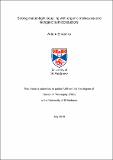Files in this item
Strong matter-light coupling with organic molecules and inorganic semiconductors
Item metadata
| dc.contributor.advisor | Keeling, Jonathan Mark James | |
| dc.contributor.author | Strashko, Artem | |
| dc.coverage.spatial | 100 p. | en_US |
| dc.date.accessioned | 2020-07-22T10:36:00Z | |
| dc.date.available | 2020-07-22T10:36:00Z | |
| dc.date.issued | 2019-12-03 | |
| dc.identifier.uri | https://hdl.handle.net/10023/20306 | |
| dc.description.abstract | This dissertation studies the effects of strong matter-light coupling on properties of organic molecules and inorganic semiconductors. The interplay of complex intramolecular dynamics and strong coupling of a photon to molecular transitions results in new physics having no counterparts in other systems. In contrast, low-energy optically active excitations of semiconductors (excitons) usually do not feature such complexity. However, the combination of strong electronic correlations and strong matter-light coupling leads to new physics. Firstly, the effect of strong coupling between molecular vibrations and infrared photons on Raman scattering (RS) is considered. This is motivated by the experiment of Ref. [1] showing up to 10³ enhancement of RS signal under strong coupling. While the exact analytical results of this dissertation predict around 100% enhancement of total RS signal, they cannot explain orders of magnitude enhancement, leaving the question open for further studies. Next, the effects of strong coupling of an optical photon and a molecular electronic transition on molecular lasing properties are discussed. Starting from a microscopic description of a driven-dissipative system, an exact (in the thermodynamic limit) mean-field solution is developed. It allows to uncover the mechanism of molecular lasing in the weak and strong coupling regime and to obtain a non-equilibrium lasing phase diagram. Finally, a semiconductor with different densities of electrons and holes, strongly coupled to a microcavity photon, is studied. While finite electron-hole density imbalance is detrimental for excitonic condensation, it may still lead to a condensed state of excitons with finite centre of mass momentum coexisting with unpaired electrons. On the other hand, due to its low mass, a photon favours zero center of mass momentum condensation. The variational mean-field calculations reveal that the interplay of these effects leads to a variety of novel states with coexisting polariton condensate and unpaired electrons. | en_US |
| dc.description.sponsorship | "This work was supported by the Engineering and Physical Sciences Research Council, the Scottish Doctoral Training Centre in Condensed Matter Physics (grant number EP/L015110/1)." -- Funding | en |
| dc.language.iso | en | en_US |
| dc.publisher | University of St Andrews | |
| dc.relation | Strong matter-light coupling with organic molecules and inorganic semiconductors (thesis data) Strashko, A., University of St Andrews, 2020. DOI: https://doi.org/10.17630/e8d899d3-7c86-4919-8076-5e7ea746e5cf | en |
| dc.relation.uri | https://doi.org/10.17630/e8d899d3-7c86-4919-8076-5e7ea746e5cf | |
| dc.subject.lcc | QC454.R36S8 | |
| dc.subject.lcsh | Raman effect | en |
| dc.subject.lcsh | Semiconductors | en |
| dc.subject.lcsh | Polaritons | en |
| dc.title | Strong matter-light coupling with organic molecules and inorganic semiconductors | en_US |
| dc.type | Thesis | en_US |
| dc.contributor.sponsor | Engineering and Physical Sciences Research Council (EPSRC) | en_US |
| dc.contributor.sponsor | Scottish Doctoral Training Centre in Condensed Matter Physics (CM-CDT) | en_US |
| dc.type.qualificationlevel | Doctoral | en_US |
| dc.type.qualificationname | PhD Doctor of Philosophy | en_US |
| dc.publisher.institution | The University of St Andrews | en_US |
| dc.identifier.doi | https://doi.org/10.17630/10023-20306 |
This item appears in the following Collection(s)
Items in the St Andrews Research Repository are protected by copyright, with all rights reserved, unless otherwise indicated.

